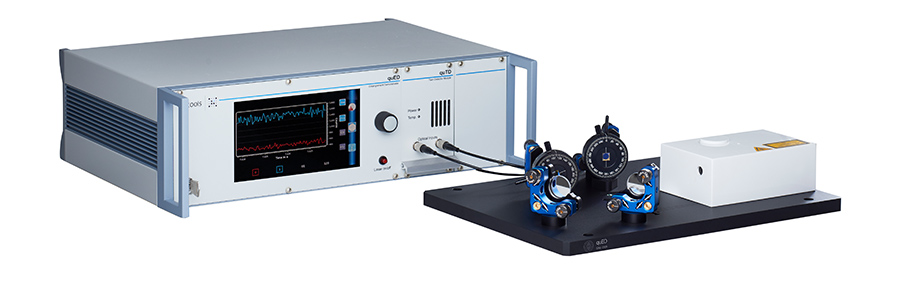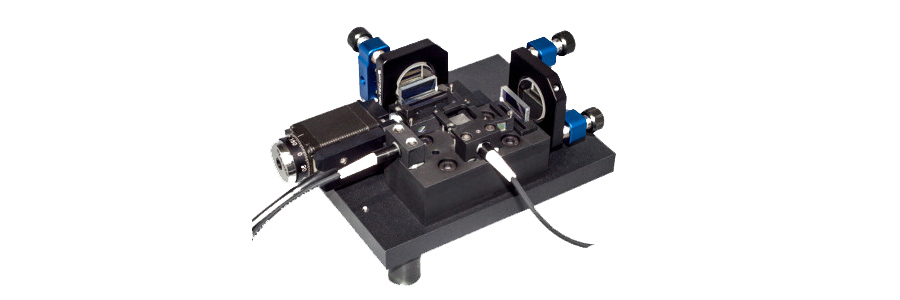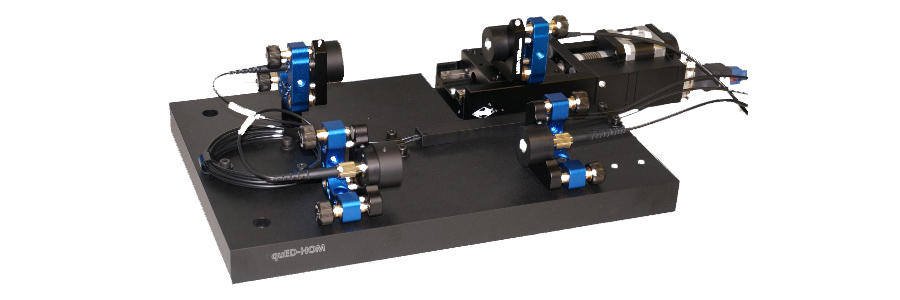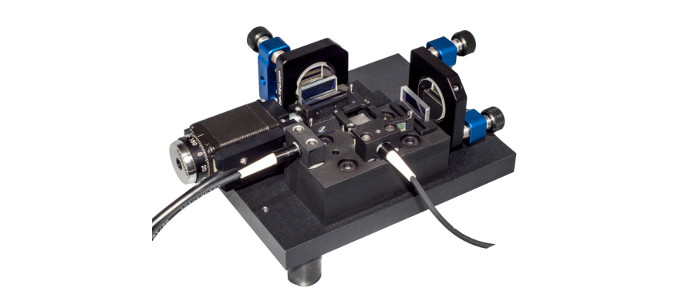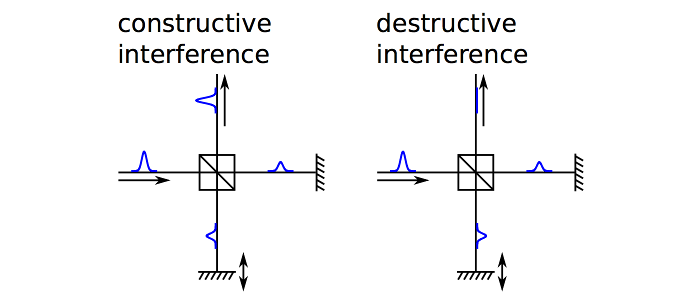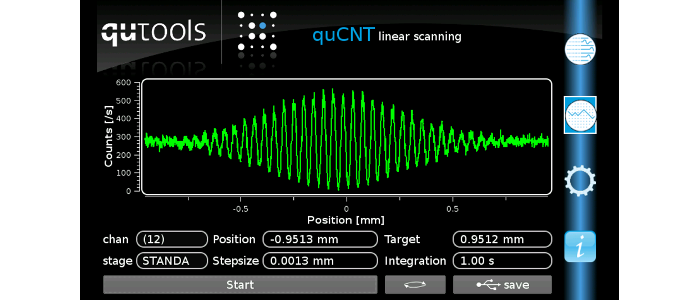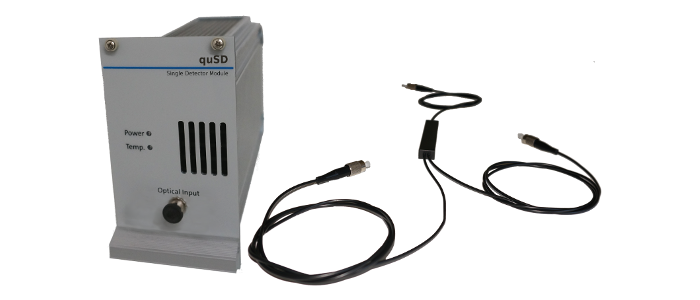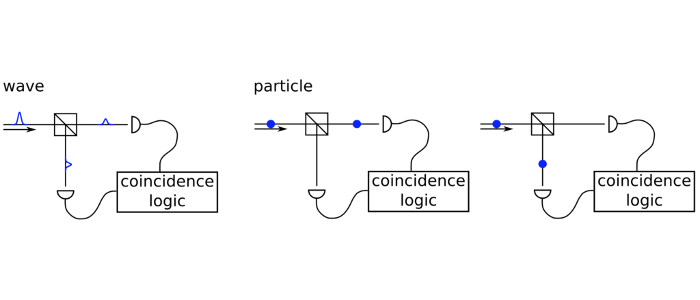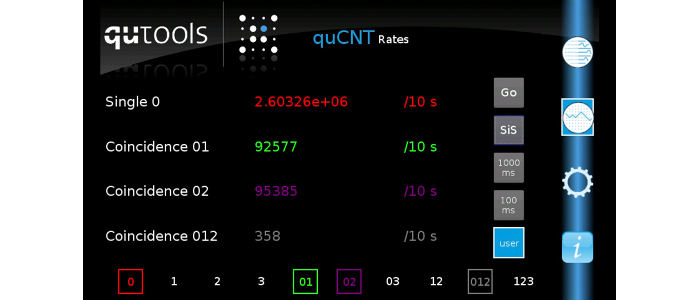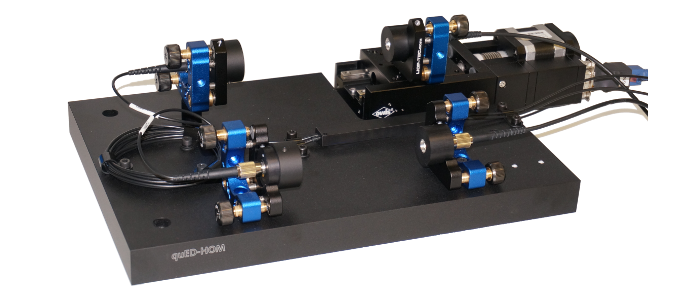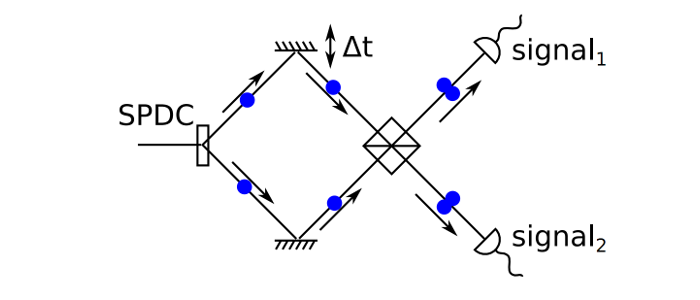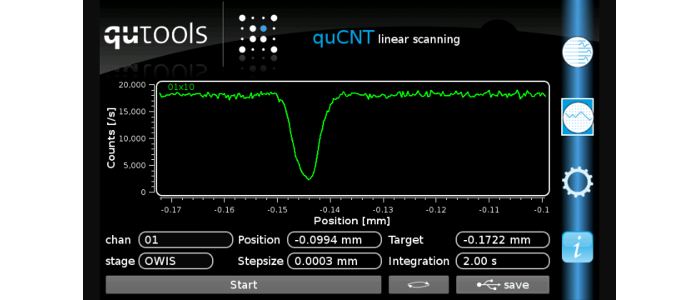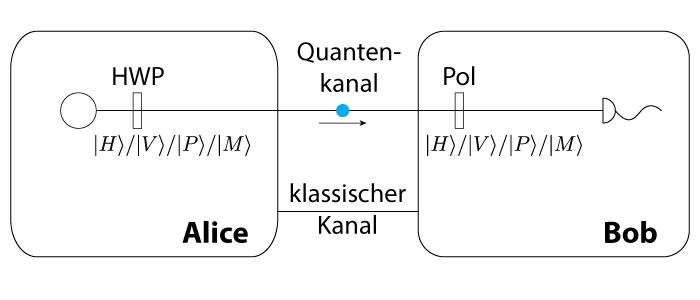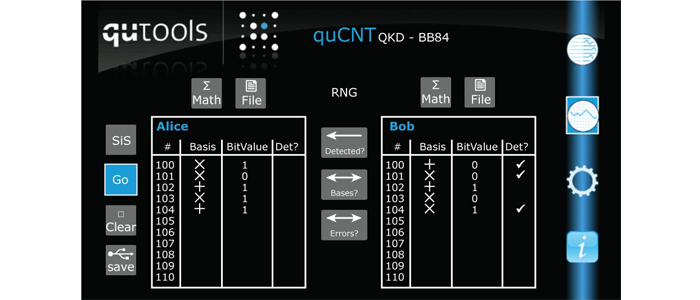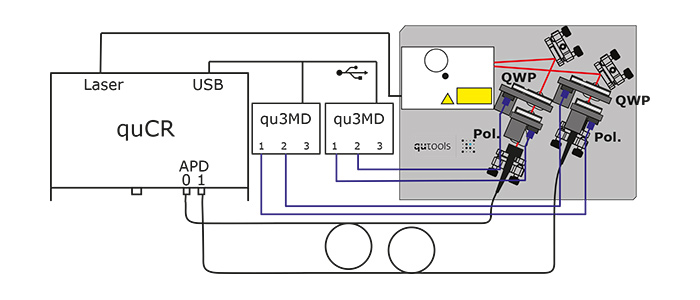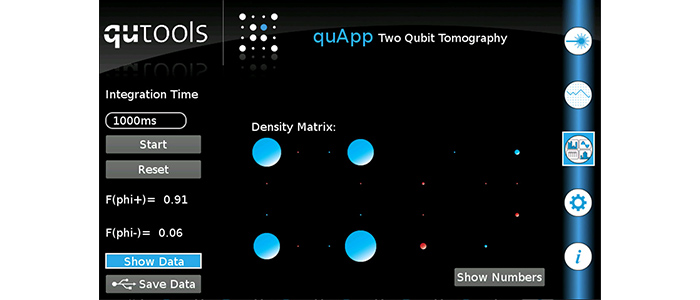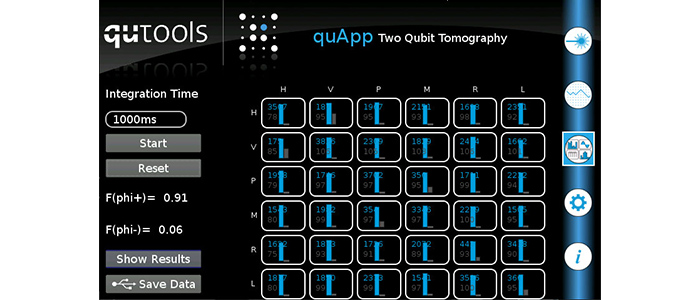A Science Kit for Quantum Physics.
- Overview
- Sample Experiments
- Add-Ons
- Key Features
- Photon Source
- References
- Applications
- System Includes
- Videos
- Downloads & Links
Quantum mechanics is deeply rooted in the heart of modern physics. But it is not easy to teach. Quantum theory often contradicts our everyday life experience and the corresponding experiments are neither easy to setup nor to maintain.When Aspect, Roger and Dalibard showed that entangled photons violate Bell’s inequality for the first time in 1982, their setup filled the whole basement lab. The quED fits on any lab desk and can be set up in minutes. And it is more accurate and a lot more efficient than the apparatus of Aspect and his colleagues.
qutools’ Entanglement Demonstrator is designed for educational purposes. The easy-to-use system frees the hands and brains of anyone trying to explain the complex phenomena of quantum mechanics. Because that’s already hard enough.
quED: “Spooky action at a distance”? Not so spooky anymore…
It’s a science project kit for modern physics.
Sample Experiments
Here is a list of the experiments you can do with the quED and its add-ons.
Single Photon Experiments without Interference
Single Photon Experiments with Interference
Photon Pair Experiments with Polarisation Entanglement
Photon Pair Experiments without Polarisation Entanglement
These are the experiments we have come up with so far and found interesting enough to put them here. Do you have more ideas? Please let us know!
The functionality of the quED system can easily be extended with these add-ons:
Key Features
The quED design combines recent achievements of quantum optics technology into an easy-to-use system for academic, research and applied purposes with precise accuracy. Advanced models for scientific purposes are available as well, with a high performance meeting the requirements of state-of-the-art physics experiments. See how the SPDC source works.
- Hands-on study of quantum entanglement
- Compact design, user-friendly operation
- Complete system: Ready to violate Bell’s inequalities
- High performance: Entanglement verification in only a few seconds
- Optional: Add-ons to extend the number of experiments
Animated Entangled Photon Source
SPDC generates entangled photon pairs
The heart of the quED and Quantenkoffer is made out of β-Barium-Borate (BBO), a special optical non-linear crystal. A high power UV diode laser at 405 nm wavelength, called the pump laser, is focused in this crystal. If the polarization of the pump beam and the axis of the BBO crystal are matched in a way enabling energy and momentum conservation, some of the pump photons are converted into two lower energy near infrared photons at 810 nm. These down con-verted photons then emerge at opposite sides of a so-called emission cone and form a photon pair.
Even though the conversion rate is low (only about 1 of 100.000.000.000 pump photons is converted), these photon pairs are quite useful, since whenever you observe a photon on one side, you know that there must be one on the other side, too! Therefore, you call them heralded single photons, and they can then be used in further experiments.
It becomes even more interesting if you add another BBO crystal with the optical axis perpendicular to the first one, condition the pump laser polarization by inserting a half wave plate (HWP) and compensate some temporal shifts and dispersion effects by two Ytterbium Vanadate (YVO) crystals: The photon pairs from the two crystals are coherently overlapped, so one cannot distinguish between pairs originated from the first or second crystal.
This is the condition for creating polarization entanglement between the photons of one such pair.
See also the brochure of the quED for more information.
For further informations at quantenkoffer.com.
References
Sebastian Will, Columbia University, NYC: “We have used the QuED setup here at Columbia University for remote instruction in our physics majors lab. Students are extremely excited using the setup and it motivates them to study the foundations of quantum entanglement in great depth. I have rarely seen students putting that much effort into a lab class as with this setup! It really makes entanglement tangible. At the same time it equips them with know-how that is essential in these times of emerging quantum technologies.“
Dr. Edward F. Deveney, Bridgewater State University, MA: “There is a new generation of quantum books now, and I think that they get to the heart of quantum mechanics in a quicker more accessible way all based on the experiments. Exciting that qutools is leading the way on the experiment side that students and most universities can do. Together you are revolutionizing the way quantum is taught, experienced, and understood. In turn it will lead to next generation quantum technologies and engineering and hopefully a deeper insight to what quantum is really telling us. I am pleased and lucky to have access to both and push for others to see these new ways to teach – I have as much fun as my students do.“
George Musser, editor at Scientific American magazine and the author “Spooky Action at a Distance” and “The Complete Idiot’s Guide to String Theory” about the quED: “Do-it-yourself quantum spooky action! An experiment that used to fill a basement lab now fits on any table.”
Dr. Eleni Diamanti, Université Pierre et Marie Curie, Paris: “We use the quED in my laboratory as a central element for our teaching activities; it is always a great and guaranteed success thanks to its stability and reliability. We have also extensivley used it in experiments ranging from the demonstration of nonlocal quantum games (Phys. Rev. Lett. 2015) to the reference-frame-independent quantification of bipartire entanglement (Phys. Rev. A 2014), more experiments are underway. “
Dr. Ulrich Busk Hoff, Danmarks Tekniske Universitet: “At DTU Physics we are proud to have high-quality products from qutools which allow us to do engaging outreach and hands-on teaching of fundamental quantum physics. The quED is an impressive product that puts everyone in a position to experiment with quantum physics. Thanks to our setups from qutools, Bell’s inequality has finally been violated for the first time in Denmark.”
Further Reading
General Publications
- Scientific American™ blog entry about our quED and more quantum entanglement.
- Article about DTU quantum phyics school lab.
- DTU QuantumLab website. Great website with plenty of photos (lots of them showing our products).
- German school “Spohn-Gymnasium” offers a experimental quantum physics project using the quED and some of its add-ons.
Scientific Publications by our Customers
- M. Neugebauer et al., Neural network quantum state tomography in a two-qubit experiment, arXiv preprint (2020): Preprint
- A. Nomerotski et al., Counting of Hong-Ou-Mandel Bunched Optical Photons Using a Fast Pixel Camera, arXiv preprint (2020): Preprint
- C. Ianzano et al., Spatial characterization of photonic polarization entanglement using a Tpx3Cam intensified fast-camera, arXiv preprint (2018): Preprint
- G. Pütz et al., Quantum Nonlocality with Arbitrary Limited Detection Efficiency, Phys. Rev. Lett. 116, 010401 (2016): PRL | Preprint
- D. Aktas et al., Demonstration of Quantum Nonlocality in the Presence of Measurement Dependence, Phys. Rev. Lett. 114, 220404 (2015): PRL | Preprint
- A. Pappa et al., Nonlocality and Conflicting Interest Games, Phys. Rev. Lett. 114, 020401 (2015): PRL | Preprint
- T. Lawson et al., Reliable experimental quantification of bipartite entanglement without reference frames, Phys. Rev. A 90, 042336 (2014): PRA | Preprint
- E. Pomarico et al., Various quantum nonlocality tests with a commercial two-photon entanglement source, Phys. Rev. A 83, 052104 (2011): Institute Website | PRA
Applications
qutools’ Entanglement Demonstrator is designed with educators in mind. It’s the easiest and most reliable way to explain the complex phenomena of quantum mechanics by generating and analysing polarization-entangled photon pairs.
Specific applications are:
- Student lab course experiments
- Demonstration experiments in lectures
- Hands-on experiments for science centers
- Project kits for students’ research centers
For demonstration experiments, we propose to use the motorised version. When students are supposed to perform the experiments themselves, the manual versions are recommended.
System Includes
The standard quED package includes everything you need to violate Bell’s inequality and perform similar experiments.
- Source of fiber-coupled polarization-entangled photon pairs
- Two silicon single photon avalanche detectors
- Alignment help utilities including auxiliary low-power visible laser module
- Four-channel counter with integrated coincidence logic unit
- Control and read-out unit
Have a look at our add-ons if you would like to perform additional experiments!
Videos
Downloads
| quED datasheet | 10/2021 | 0.5 MB | |
| quED quickstart manual | 10/2021 | 0.5 MB | |
| quED manual | 10/2021 | 19.1 MB | |
| quCR manual | 10/2019 | 5.0 MB | |
| quED brochure | 10/2021 | 2.4 MB |
Videos
| quED – Introduction | 05/2020 | video | |
| quED – Violation of Bell’s Inequality | 05/2020 | video |
Work Sheets & Courses
| Alignment | 04/2021 | ||
| Bell’s Inequality | 09/2019 | ||
| Sample Lab Course | 06/2022 |
Links
| Spontaneous parametric down-conversion | 05/2020 | animation | |
| The Photon and the Second Order Correlation Function | 04/2021 |

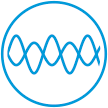 Interferometers
Interferometers Time-Tagger
Time-Tagger Quantum Physics Kits
Quantum Physics Kits